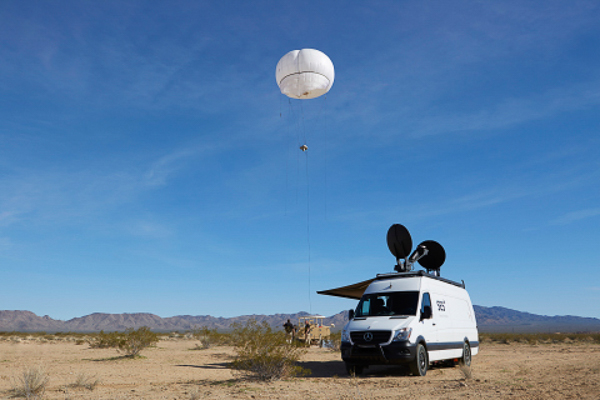
Global satellite communications company, SES, has released its first-quarter results for 2017, showing revenue of €540.6 million, up 12.2% against 2016.
The company showed an EBITDA margin of 66.2% and operating profit margin of 34.5%, a net profit attributable to SES shareholders of €128.4 million up 11.5% on 2016. The net debt to EBITDA ration is 3.05, up from a year ago, but in line with SES’s financial framework.
The company attributes the positive results to an improved business mix that has supported growth acceleration.
Karim Michel Sabbagh, President and CEO, said the results were in line with expectations.
“The first quarter 2017 results were fully in line with our expectations. SES returned to growth in Q1 2017 with all of our data-centric markets developing positively, and we remain well placed to deliver sustained growth in all four of our market verticals. The restructuring of SES’s go-to-market organisation model, with the creation of two natural business units, represents a further acceleration of our market-centric strategy. With SES Video and SES Networks, we are coalescing our differentiated capabilities to best serve customers globally,” he said.
“The launch of SES-10 on SpaceX’s first ever mission using a flight-proven rocket was a further step towards more efficient launch capabilities, and is yet another demonstration of SES’s strategy of working with our industrial partners to be at the forefront of innovation.
In April 2017, the company’s Board approved a restructuring of SES’s go-to-market organisation model with the creation of two highly focused communities – SES Video and SES Networks. The new organisation, which will be implemented during 2017, allows SES to deliver increasingly differentiated and essential satellite-enabled communication solutions to clients in the video and data-centric verticals.
Ferdinand Kayser, formerly Chief Commercial Officer, was appointed CEO of SES Video. Steve Collar, formerly CEO of O3b, was appointed CEO of SES Networks, which comprises the Enterprise, Mobility and Government verticals and integrates O3b.
Video accounted for 65% of group revenue (71% in Q1 2016).
• Reported revenue up 4.5% to EUR 353.4 million (-4.2% like for like)
• Lower periodic and services revenue were largely behind the movement in (like for like) revenue
• Contribution from further HD/UHD growth and new capacity in fast-growing markets support stable to slight growth (like for like) outlook for FY 2017
Lower periodic and services revenue in Q1 2017 largely accounted for the (like for like) revenue reduction over the prior period. The balance reflected a modest volume movement related to the timing of MPEG-4 expansion in line with the group’s long-term objective of sustaining the upgrade of the viewing experience to High Definition (HD) and Ultra High Definition (UHD).
As at 31 March 2017, the SES global fleet carried 7,610 total TV channels, which was 4% higher than 31 March 2016. SES’s HDTV channel count grew by 6%, year-on-year, to 2,496 channels, while the SES satellite network now also carries 22 commercial UHD channels (31 March 2016: 15). 63% of total TV channels are broadcast in MPEG-4 (31 March 2016: 57%).
SES’s satellite fleet is broadcasting video content to 325 million households around the world, which represents an increase of around 8 million households (or 3%) over the prior year.
The main highlights in Video included:
• SPI International/FILMBOX Channels Group signed a multi-year capacity agreement to extend audience reach in Latin America and broadcast 10 HDTV channels to the region;
• Media Broadcast Satellite and SES agreed a multi-year capacity extension contract for use of a full transponder at 19.2 degrees East to continue to serve customers in Germany, Austria and Switzerland;
• SES’s UHD trials in North America continued to gain momentum by adding seven additional U.S. cable operators to the test platform, which is now working with 15 cable operators across the U.S.;
• SES announced a collaborative agreement with Verizon for testing of UHD in North America to drive the overall development of UHD delivery solutions for Verizon Fios, which is currently serving over 4.5 million video subscribers in the U.S.; and
• Successful launch of SES-10, on SpaceX’s first ever mission using a flight-proven rocket, which will serve the Andean Community (Bolivia, Columbia, Ecuador and Peru) for direct-to-home broadcasting as well as enterprise and mobility services.
In addition, MX1 secured a long-term contract renewal and expanded agreement with Beta Film Ltd. for a range of media services, including content management, using the MX1 360 platform. MX1 360 is a centralised, cloud-based media asset management solution, which was also recently contracted by the Israel Premier Football League to provide an end-to-end service for live editing of sports content.
In January 2017, MX1 and Sky Deutschland agreed a multi-year contract extension for the provision of back-up services to enable business continuity. The agreement includes playout and turnaround services, such as encoding, multiplexing and encryption, and uplink services.
In April 2017, a multi-year distribution agreement was signed between MX1 and VUBIQUITY. The new service offers broadcasters, TV channels and rights holders the ability to aggregate content and reach millions of viewers in the U.S. and worldwide, quickly and simply through a single platform. This was followed by an agreement for MX1 to support the linear broadcasting requirements for a major global video on demand platform.
Enterprise: 13% of group revenue (Q1 2016: 12%)
• Reported revenue up 19.7% to EUR 71.7 million (+0.6% like for like)
• Further capacity increases by existing O3b clients supporting overall trend of return to growth in Enterprise, in line with expectations for FY 2017 (like for like) revenue development
• Building positive traction for SES (GEO) Enterprise+ services
The main highlights in Enterprise included:
• Intersat signed a multi-year capacity agreement for the delivery of internet solutions across Africa, using the SES Enterprise+ Broadband service. The agreement included a new C-band capacity lease as well as the renewal of Ku-band capacity and supporting teleport services;
• Palau Telecoms increased network capacity for the fifth time in under two years, nearly doubling its capacity requirement since going live on the O3b Medium Earth Orbit (MEO) network;
• Timor Telecom extended their contract for O3b services, which now delivers more than one gigabit per second of low latency connectivity delivered to two sites operated by Timor Telecom; and
• Presta Bist Telecoms increased by 66% its contracted capacity with O3b in response to rising demand for reliable, high-speed broadband in the Republic of Chad.
Mobility: 9% of group revenue (Q1 2016: 5%)
• Reported revenue up 126.4% to EUR 50.5 million (+63.3% like for like)
• Q1 2017 included upfront contribution from Global Eagle Entertainment (GEE) related to AMC-3 contract
• Continued expansion of aeronautical and maritime solutions underpin strong growth outlook for FY 2017
The main highlights in Mobility included:
• GEE announced the acquisition of a Ku-band payload on SES’s AMC-3 satellite to boost capacity for customers in North America, the Gulf of Mexico and the Caribbean;
• Satcom Global contracted capacity on both SES’s existing fleet and upcoming next generation hybrid satellites with high throughput payloads, as well as ground network infrastructure, to support delivery of seamless and high-speed connectivity solutions to maritime, offshore and land customers;
• SES and Gilat Satellite Networks announced a strategic collaboration to deliver connectivity for small yachts and vessels in the Caribbean, the Mediterranean and North Sea, as well as Southeast Asia; and
• Gogo signed a new contract to use capacity on 12 Ku-band transponders, and supporting ground infrastructure, to expand high-speed inflight connectivity services over the U.S. and Canada.
The agreements with GEE and Gogo reflect SES’s unique approach of leveraging its global fleet, including non-station-kept satellites, to support growth opportunities across the Mobility sector.
Government: 11% of group revenue (Q1 2016: 12%)
• Reported revenue up 4.5% to EUR 59.4 million (+2.4% like for like)
• NATO Alliance Ground Surveillance (AGS) contract and growth in O3b Government driving return to growth, in line with expectations of stable to slight (like for like) revenue growth for FY 2017
The main highlights in Government included:
• SES Government Solutions (SES GS) continued to benefit from increasing stabilisation in U.S. Government demand, which continues to recover from the impact of the U.S. budget sequestration;
• SES and the Luxembourg Ministry of Foreign Affairs extended a contract to maintain and support SATMED, a satellite-enabled e-health platform, until 2020; and
• SES launched the Rapid Response Vehicle (RRV), a new Government+ solution, capable of delivering multi-orbit (GEO-MEO) and multi-frequency connectivity for a broad range of government missions.
Future satellite capacity
On 30 March 2017, SES-10 was successfully launched into space on board a SpaceX Falcon 9 rocket, becoming the first geostationary satellite to launch on a flight-proven first-stage rocket booster. The satellite is expected to begin commercial service by the end of May 2017 and will provide capabilities for direct-to-home broadcasting, enterprise and mobility services.
In April 2017, SES and Thales Alenia Space announced the addition of a powerful Digital Transparent Processor (DTP) on board SES-17. The fully digital SES-17 spacecraft will provide customers with an unsurpassed ability to efficiently and flexibly modify their networks in real time. This will enable customers to deliver high-speed connectivity in a more efficient and cost effective manner.








